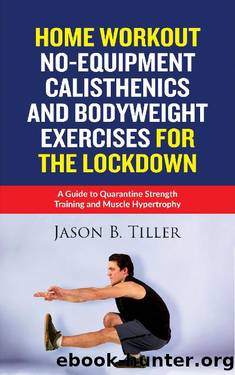Home Workout No-Equipment Calisthenics and Bodyweight Exercises for the Lockdown: A Guide to Quarantine Strength Training and Muscle Hypertrophy by Jason B. Tiller

Author:Jason B. Tiller [Tiller, Jason B.]
Language: eng
Format: epub
Published: 2020-04-30T22:00:00+00:00
The Posterior Chain ; is found in the rear side of the human body, and they are made up of the calf muscles, hamstrings, and lower gluteal muscles. Well developed and maintained posterior chain muscles offer the body proper movements, support, and strength. A regular series of calisthenics workout sessions will bring about muscle building, and this can be carried out through planks, lunges, and squats. You can also incorporate other forms of exercises that focuses on this region of the body for a well-distributed growth.
Nervous System Training
In as much as calisthenics is mostly used to strengthen and develop muscle mass, you should also be aware of its importance in strengthening the nervous system. For a wholesome and all-encompassing workout, you should aim to bring together elements that will develop both your muscle mass and nervous system.
Your nervous system, which comprises of the brain, spinal cord and nerve ends which are distributed all over the body when subjected continuously to calisthenics exercise will make your body to become agile through the development of the motor and other critical neural sites in the body.
Training regimes of relative high intensities and long durations will boost the endurance level and, consequently, the strength and mental alertness levels. Nervous system training is often overlooked by beginners when starting with calisthenics through intense workout sessions.
The exercises of the nervous system are majorly comprised of the plyometric workout, which is a sudden fast-paced activity aimed at developing strength and stability. It focuses on several joints at the same time all over the body e.g., dips, squats, benches, rows, pulldowns, and bent over rows. How often and the rate of giving your nervous system the required workouts is most times advisable to be on the high side. Giving your nervous system a good workout at least twice a week will ensure that the desired results are gotten and maintained. You can as well increase the frequency and intensity of the workouts for faster results. If you are a beginner, you should bring in the whole body workout into the nervous system training.
For effective results, you should combine and switch as you see appropriate between muscular and nervous system training. This will bring about equilibrium in the development and growth of cardiovascular endurance and efficiency. There is no hard and fast rule on the proportion of combination to be carried out between the nervous and muscular training. However, for beginners, it is necessary to dedicate more hours to developing the nervous system as this will serve as the foundation needed for further exercises later that will focus on bodyweight exercises for bulking up and strengthening the muscles.
As a beginner, you can start with about three to four weeks for nervous system training before you move onto bodyweight training for three to four weeks before going back to the nervous system training. The time frame spent on each form of exercise can be adjusted to suit your peculiar needs, and soon enough, you will begin to see changes.
For bodyweight
Download
This site does not store any files on its server. We only index and link to content provided by other sites. Please contact the content providers to delete copyright contents if any and email us, we'll remove relevant links or contents immediately.
How to Be a Bawse: A Guide to Conquering Life by Lilly Singh(6693)
Deep Work by Cal Newport(5471)
The Longevity Diet by Valter Longo(4446)
The Fat Loss Plan by Joe Wicks(4239)
The Four-Pack Revolution by Chael Sonnen & Ryan Parsons(3485)
The Ultimate Bodybuilding Cookbook by Kendall Lou Schmidt(3320)
The French Women Don't Get Fat Cookbook by Mireille Guiliano(2984)
Super Food Family Classics by Jamie Oliver(2912)
Turn Up Your Fat Burn! by Alyssa Shaffer(2812)
Factfulness_Ten Reasons We're Wrong About the World_and Why Things Are Better Than You Think by Hans Rosling(2754)
Not a Diet Book by James Smith(2726)
Tom Kerridge's Dopamine Diet: My low-carb, stay-happy way to lose weight by Kerridge Tom(2677)
Body Love by Kelly LeVeque(2630)
Self-Esteem by Matthew McKay & Patrick Fanning(2604)
The Unbecoming of Mara Dyer by Michelle Hodkin(2483)
Tone Your Tummy Type by Denise Austin(2368)
The Fat Chance Cookbook by Robert H. Lustig(2321)
LL Cool J's Platinum 360 Diet and Lifestyle by LL Cool J(2313)
Men's Health Best by Men's Health Magazine(2093)
